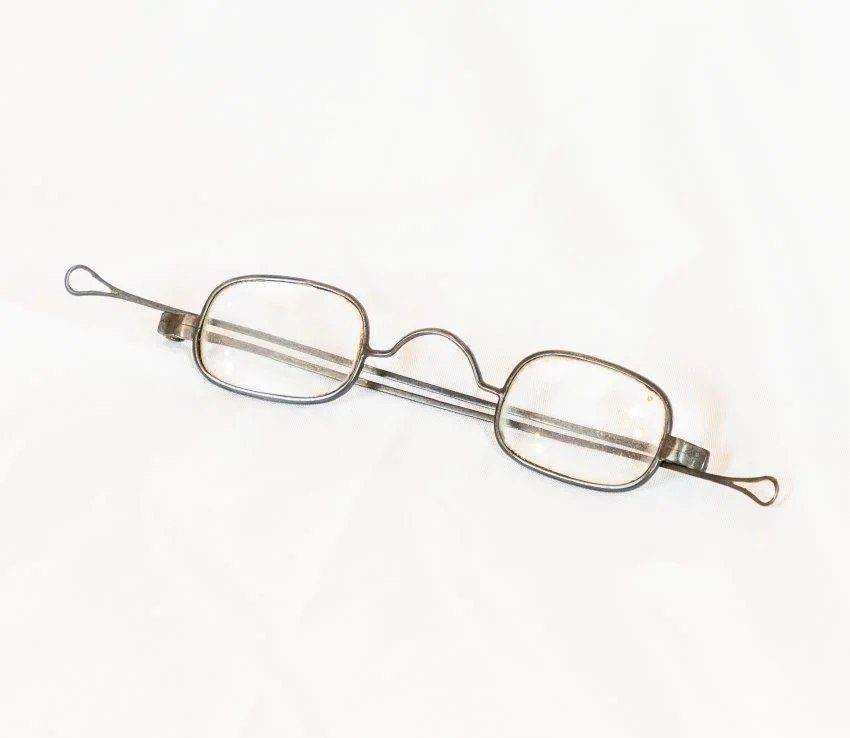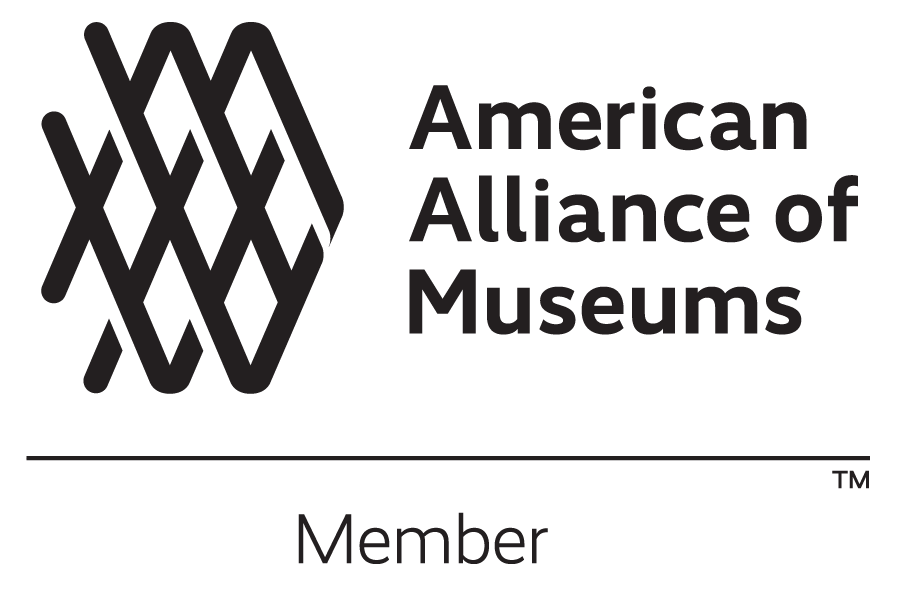Merchants of Vision: New York’s Optical Marketplace
By Armonee Wilkins
Programs & Events Coordinator Armonee Wilkins examines the evolution of vision science through the craftsmanship of George Adams and New York’s 18th-century optical trade.
Eyeglasses, 18th century
Gift of Craig Hamilton Weaver, 2025.
The Science of Seeing: George Adams and Vision
In the 18th century, the study of sight sat at the intersection of science and craftsmanship, a boundary mastered by the Adams family of London. George Adams (1720–1773), a renowned scientific instrument maker for King George III, gained fame for his precision work with microscopes, telescopes, and optical lenses. His treatise, An Essay on the Microscope (1787, published posthumously) captured the Enlightenment spirit of inquiry—viewing instruments not just as tools for discovery but as products of mathematical and mechanical perfection. His workshop became a symbol of this ideal, where artistry met the precision of physics.
His son, George Adams, Jr. (1750–1795), carried that legacy forward into the realm of human vision. In his Essay on Vision (1792), he described sight as “such a refraction of the rays of light as will form a distinct picture on the retina,” explaining how clarity depended on the lens’s exact curvature and polish [1]. Adams, Jr. warned against “spectacles of hawkers,” cheaply made lenses that could harm the eyes [2] , instead promoting scientifically designed glasses for healthy vision. Under his direction, the Fleet Street workshop produced spectacles, spy glasses, and microscopes exported across Europe and the American colonies. Near Fraunces Tavern in New York, merchants such as James Rivington sold Adams’s imported spectacles, ranging from eight shillings to twenty dollars [3] (in present day this is $45.95 to $2,297.96). Through both scholarship and craft, the Adams family transformed their vision into a field of science and commerce, bridging London’s optical innovation with New York’s bustling marketplace.
Merchants of Vision: New York’s Optical Trade
Advertisement for Scientific and Mathematical Works, 18th century
Published by James Rivington,
The application of scientific knowledge expanded in late 18th-century New York City, where an increasingly literate and commercially active population required instruments for reading, writing, and navigation. Near Fraunces Tavern, Pearl Street and Wall Street emerged as prominent centers of urban craftsmanship.
John Benson was a notable early optician, he specialized in crafting lens, aiding the wearer’s vision, he operated a store with spectacle, optical, and lapidary services—specializing in gem cutting and engraving. Benson’s store opened first at 5 Maiden Lane, then 106 Pearl Street [4], and later relocated to 147 Pearl Street [5]. His inventory included spectacles with pebbles (natural quartz), recognized for their clarity and durability, green goggles designed to reduce glare, and opera and spy glasses intended for leisure and travel [6]. Benson’s enterprise exemplified the intersection of scientific advancement and the fashionable preferences of New York City's merchant class.
Spectacles and other lenses were in high demand. Other notable vendors included J. Grayton, located at 142 Pearl Street, who offered comparable optical products, serving clients interested in recent European styles and advancements in lens manufacturing [7]. The Widow of Sommer, residing on Beekman Street, promoted her expertise in producing various types of glasses, including spy, opera, and reading glasses [8]. This evidence indicates that women contributed to the expansion of New York City's optical industry.
Thomas Biggs operated at 32 Wall Street, providing high-quality spectacles to both professionals and sailors [9]. His location near New York's commercial center attracted a consistent clientele of merchants and travelers who required precise vision for managing ledgers, maps, and correspondence.
The Craft Behind the Clarity
The manufacture of spectacles required specialized skills beyond manual dexterity. Artisans such as Adams and his contemporaries in New York employed glass grinding, lens polishing, and precise metalwork to produce lenses that corrected vision without distortion. Lenses were commonly fabricated from imported flint glass or natural quartz pebbles, shaped by hand using a copper grinding plate coated with emery dust [10] (the same emery dust that is responsible for filing nails today). Frames were constructed from materials such as silver, tortoiseshell, or brass, each providing both structural support and indicating the wearer’s social status [11].
Traveling Trunk of the Van Keuren Family, late 18th century
Gift of Craig Hamilton Weaver, 2025.
These visual aids represented a changing world where improved vision was necessary for trade, literacy, and international interaction. From Benson's Pearl Street store to Rivington's bookshop, eyeglasses represented the connection of art, science, and business. Like the Van Keuren trunk displayed in Lodging at Fraunces Tavern—tooled in black leather and adorned with brass initials, spectacles symbolized mobility, wealth, and the modern sensibilities of merchant class. At Fraunces Tavern, such successful merchants could have stayed overnight in a private bedchamber while engaging in business in the tavern during the day. When you visit, take a look at the eyeglasses on the bedroom writing table—a connection to the booming merchant business in the area. Americans in the 18th century were able to see not only the world around them but also the modernity that was emerging day by day.
Footnotes
[1]Adams, George, Jr. An Essay on Vision: Briefly Explaining the Fabric of the Eye and the Nature of Vision. London: Printed for the Author, 1792, p7
[2]Adams, George, Jr. An Essay on Vision: Briefly Explaining the Fabric of the Eye and the Nature of Vision. London: Printed for the Author, 1792, p 18.
[3] Rivington’s New-York Gazetteer, advertisements for spectacles “made by George Adams,” c. 1774.
[4] “Notice for John Benson’s Shop.” Daily Advertiser (New York, NY), July 18, 1797.
[5] “Advertisement for John Benson’s Optical and Lapidary Store.” New-York Gazette and General Advertiser (New York, NY), June 7, 1789.
[6] “Notice for John Benson’s Shop.” Daily Advertiser (New York, NY), July 18, 1797.
[7] “Notice by J. Grayton.” New-York Gazette and General Advertiser (New York, NY), August 23, 1799.
[8] “Notice for the Widow of Sommers.” New-York Gazette and General Advertiser (New York, NY), November 11, 1751.
[9] “Notice for Thomas Biggs.” New-York Gazette and General Advertiser (New York, NY), March 20, 1793.
[10] “Notice for John Benson’s Shop.” Daily Advertiser (New York, NY), July 18, 1797.
[11] “Notice for John Benson’s Shop.” Daily Advertiser (New York, NY), July 18, 1797.
References
Adams, George. An Essay on the Microscope. London: Dillon and Keating, 1787.
Adams, George, Jr. An Essay on Vision: Briefly Explaining the Fabric of the Eye and the Nature of Vision. London: Printed for the Author, 1792.
“Notice for the Widow of Sommers.” New-York Gazette and General Advertiser (New York, NY), November 11, 1751.
New-York Gazette and General Advertiser (New York, NY), June 7, 1789.
“Notice by J. Grayton.” New-York Gazette and General Advertiser (New York, NY), August 23, 1799.
“Notice for Thomas Biggs.” New-York Gazette and General Advertiser (New York, NY), March 20, 1793.






